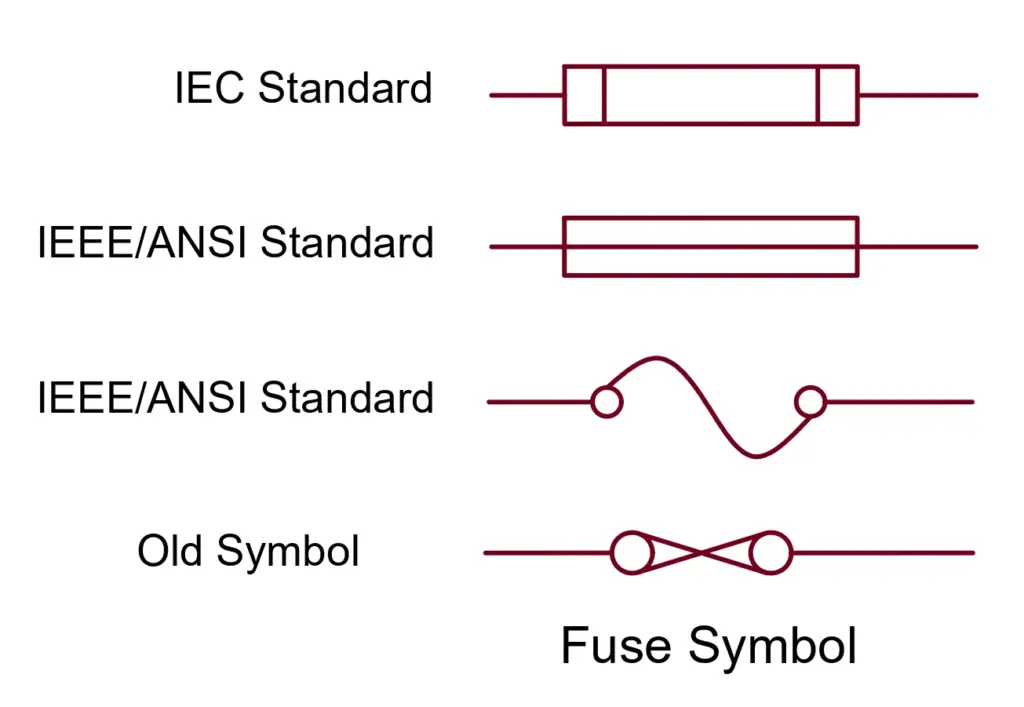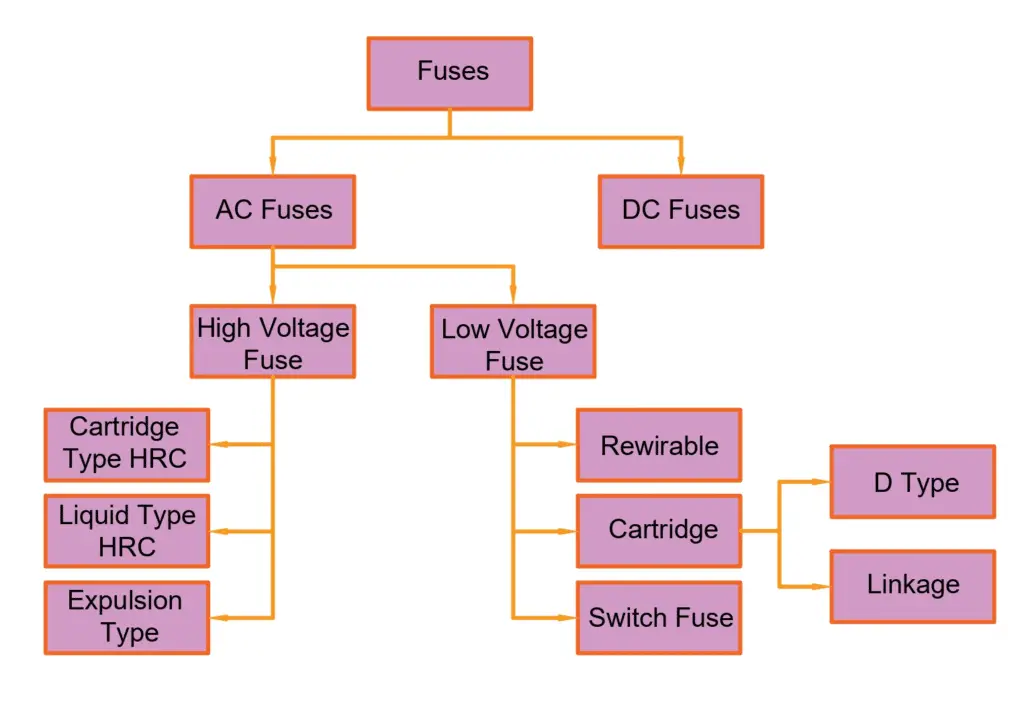This article describes a step-by-step guide to choose the right fuse for a panel. The fuse in the control panel is used to protect against electrical overcurrent and short circuits. The name fuse is derived from its fusion. The filament in the fuse conducts electricity and melts in the event of overcurrent because of a rise in temperature.

Working Principle of Fuse
A fuse is designed to provide safety to cut off the electrical current in the event of an overload or a short circuit. The main component of the fuse consists of a conductive wire enclosed by a small insulator. When the current flowing in the filament wire crosses above the rated capacity of the fuse, it melts down and breaks the electric circuit. The below-given circuit diagram has a fuse in the series of the load.

Therefore, it prevents fire hazards as well as the destruction of the entire system by breaking the electric circuit during a period of overcurrent.
Purpose of Fuse
- A fuse serves the main purpose to protect personnel and equipment from the dangers of overcurrent. The fuse is far superior to other protective devices for safety function that is still leading today.
- The fuse provides reliable, simple, and economical protection. Breaking a circuit under load always leads to the formation of an electric arc. The fuse prevents potentially catastrophic prolonged overcurrent.
Symbol of fuse
The followings are the symbols of the fuse.

Useful Terms when we use a fuse in a circuit
The following terminology must be understood before choosing the right fuse for a panel.
Overcurrent
In electrical circuits, over currents arise when the normal charging current exceeds the maximum limits. There are two basic forms of over currents called
- Short circuits and
- Overloads
Short circuit
A short circuit is an overcurrent condition that is generated when an abnormal and low-resistance circuit path is introduced into a circuit. This low resistance path bypasses the normal load and can produce extremely high currents (over 1000 times the normal current under certain circumstances).
During short circuits, there creates an abnormally low resistance path is created resulting in circuit currents increasing and decreasing the circuit resistance. The current when a short circuit occurs can exceed 1000 times the normal current of the circuit.
Overload
An overload is an overcurrent condition where the current exceeds the full load capacity of a circuit but no fault condition (short circuit) is present. A mandatory overload condition (also known as transient current) can also occur when a circuit is first started due to capacitor charging and/or motor starting.
Fuses of the modern age
In today’s control panels, most cartridge fuses have a witness (a red pellet) to identify if they are in still good condition or got blown out. If the fuse blows, the indicator red LED light disappears. In this way, we can check the status of each fuse with our naked eyes in the control panel.
How to Choose the Right Fuse
Let us understand the parameters and specifications of the fuse for choosing the right fuse for a particular application.
Parameters and specifications of Fuse
For choosing the right fuses, the following parameters and specifications must be taken into consideration:
Breaking capacity
The value of the prospective short-circuits current is that the fuse is capable of breaking most reliably without catastrophic failure like fire, explosion, etc. This is to absorb the energy generated by the electric arc during its blow.
I2T (Ampere Squared Seconds)
The I2T value of a Fuse indicates the heat energy in the fuse when it is put in the circuit. When current flow through a fuse heat energy equal to I2t develops in the fuse element. The I2t of the fuse must be lower than the I2t of the device( like SCR, Diodes, etc). The special type of fuse that has a lower heat value than the semiconductor devices are called a semiconductor fuse.
Operating voltage
It is also called nominal voltage, the maximum voltage value to which the fuse is subjected. The voltage rating of fuses should always be higher than the voltage rating of the circuits they protect. As an example, if the circuit voltage is 24 V, then the fuse’s voltage rating must be greater than 24 V.
Melting point
It is the fuse opening temperature that depends on the type of metal or alloy wire used. For example, the copper wire melting point is 1190 °C. Zink, Tin, Lead, Aluminum, and Silver are used.
Selection of amperage of a fuse
We use the calculation P (watts) = V (watts)* I (amps) to determine the amperage of a device that is not stated in the instruction, the label on the device, or elsewhere.
Example: For a 100W device operating at 12V, we will have 100/12 = 8.33amps.
To select the correct fuse amperage, one must first understand the steady state current of the circuit at an ambient temperature at full load. When the value of the current has been determined, the rating of the fuse must be selected according to 135% of this value.
Suppose, if the normal steady state current is calculated to be 10A, then a 15A-rated (a little higher rated) fuse should be selected.
10A*135% = 13.5A, the next larger standard size is 15A.
Fuse operating ambient temperature
Fuses are heat-sensitive devices which means that they respond to heat (via overcurrent) to melt the fusing element inside the fuse. The higher the heat, the faster the fusion element melts. The less heat, it takes longer time to melt the melting element.
If a fuse is subjected to a temperature greater than 20 Deg C, then the fuse amperage must be increased. This is to compensate for the high temperature, and thus avoid “false trips”.
Furthermore, a fuse’s amperage must be reduced if it is used at a lower temperature. Otherwise, it will never open.
There is a general rule of thumb that if that temperature raises by 20 Deg C, then the fuse rating should be lowered by 10% to 15% or so.
Fuse re-rating
Re-rating a fuse is necessary when higher ambient temperatures are present inversely, when a fuse is supposed to be in extremely low-temperature conditions, the fuse has to be rated lower than it would be under normal conditions.
Is the device intended to protect, overload, or both?
If the fuse is to be used for short-circuit protection, the fuse must interrupt the fault immediately (typically less than 4miillisec) to provide maximum protection for equipment and personnel.
If the fuse is intended to protect against overloads only, then they can be much slower in their reaction to an over currents seconds, or even minutes, compared to a few milliseconds…..
All fuses offer some or both forms of short-circuit protection as well as overload protection. Mostly, the fuses are used for short-circuit protection. However, the slow blow fuses protect the circuit from overloading.
We must know the fusing technology before choosing the right fuses. Let us discuss the types of fuses and their categories.
Classification of fuses

Classification of fuses according to usability
There are two types of fuses.
- Single-use fuses and
- Resettable Fuses.
Single Use Fuse
Single-use or one-time-use fuses are just what their name implies. A fuse must be replaced, once the link inside has got melted. They are used in every electronic circuit and loop.
Resettable type fuses
The Resettable Fuses, on the other hand, get automatically reset after clearing the fault.

A polymeric (PTC) fuse is an example of a resettable fuse. These fuses are limited to circuit applications providing 14A (at 12V) and even higher current voltages. They are used in process control equipment, consumer electronics, and medical equipment.
Both the above types of fuses provide overload protection.
Classification of fuses according to Current Limiting Feature
Current Limiting Fuses
A current limiting fuse breaks the electric circuit within 1/2 cycle when a short circuit occurs. Thus, the fuse breaks the current before the overcurrent reach to instantaneous short-circuit value in the circuit.
non–current-limiting fuses
The non-current limiting fuse allows the instantaneous short-circuit current in the circuit and then the fuse element melts according to the I2t rating of the fuse.
Classification of fuses according to Types of Circuit
There are two different types of circuits. The alternating current (AC fuse) and DC fuse (direct current) in a respective circuit, are called accordingly.
- AC fuse
- DC fuse
AC fuse
AC power is the power typically found in homes that comes from utility power. With AC power it is common for both current and voltage to oscillate back and forth with a certain standard frequency. This oscillation favors the fuse to clear the fault quickly. His type of fuse is small in size Due to this, the possibility of an arc between the melted wires is less.
So the distance between the electrodes is less, and hence size is also small.
DC fuse
DC power is commonly used in electronic applications. The DC supply doesn’t oscillate but is uniform so the fuse must find some other way to clear itself when it opens. When the fuse is blown off, there is a chance of an arc between the melted wires. To overcome this problem, the electrodes as placed apart form at a large distance. Hence, this type of fuse is large in size.
Cost consideration
The cost consideration must not be given priority while choosing right fuses because the lower-cost fuses may not protect your circuit. Therefore, the fuses must be of high quality and very reliable.
Cost aspects can vary by many degrees depending on the size, performance, and installation of the fuse.
Generally speaking the larger the fuse the more expensive it will be (due to the higher cost of the materials used to make it). The performance of the characteristics of a given fuse is also an important aspect of cost safety agency approvals also add to the overall of the fuses.
One of the biggest costs of the fuse is a fuse holder. Fuses for the panel mount are often much more costly than the fuse itself.
For choosing the right fuses, the above points discussed in this article must be considered to safeguard the electric circuit.